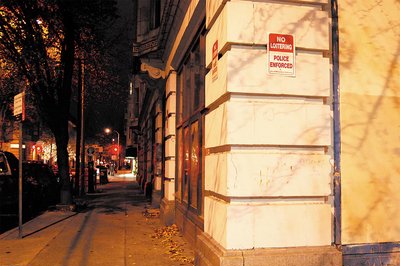Within three separate half-hour intervals in a two-day stretch last month, police arrested 12 men for prostitution-related offenses within the Gayborhood. Despite the arrests, however, police say the suspects are likely to return to the streets — if they haven’t already — in an area that has been plagued for years with prostitution and related detriments.
When Sixth District Sgt. Dominic LaRose began with the department in 1986, he said the area now known as the Gayborhood was contending with a large population of female prostitutes. As the neighborhood changed and the LGBT community became more visible, it became a haven for transgender and gay prostitutes — who LaRose said are not as likely to be able to find as much work in other parts of the city.
“It’s a lot more difficult to drive out gay prostitution because this area is such a hub of gay activity and gay bars,” he said. “It’s hard to push gay prostitutes away from the area, because this is where most of their clientele is. That’s one of the main difficulties we’ve faced in dealing with this problem.”
Police say the sex workers who frequent the Gayborhood are largely not from the area, but many hail from South Philadelphia and some even come in from the suburbs or New Jersey. They represent a mixture of races but have in recent years been trending older, with very few of those arrested for prostitution under 30, LaRose said.
And for many of the prostitutes, repeat run-ins with the law are expected.
“I’ve never brought anyone in for their first prostitution arrest,” said Sixth District Sgt. Daniel Taylor.
Sixth District Capt. Brian Korn noted that it’s difficult to determine the actual level of prostitution happening, as it can only be measured by the number of arrests, which, until recently, could only be performed by the Citywide Vice Unit.
Several Sixth District officers and one supervisor earlier this year were trained on prostitution arrests by Vice, enabling them to perform such arrests without the presence of a Vice member — an effort that had been encouraged by the Police Liaison Committee, which works to connect the police and the LGBT community.
“Before now, only the Citywide Vice Unit could make prostitution arrests, and they were spread out doing cases all over the city, so we weren’t able to get the full time and attention for the Sixth District,” explained Korn.
The officers participated in classroom-type instruction and also spent time on the street with the Vice Unit.
LaRose, who was trained, said that, while prostitution undoubtedly plays a major role in the Gayborhood, the issue is even more prevalent in other areas, most notably along Kensington Avenue.
But now that the Sixth District has the ability to handle the problem itself, Korn said the officers are better equipped to reduce prostitution in the area.
“The prostitution arrests are going up because we now have officers who can make those arrests. The officers needed to be trained because you have to meet certain legal criteria in making the case for solicitation, so the officers need to know how to make that case so the DA can prosecute,” he said.
COMPLICATIONS & RESPONSE
What complicates the issue further, however, are the difficulties police face in arresting the “johns” soliciting the prostitutes.
Taylor said most of the men who pick up prostitutes in the Gayborhood fit the over-40 demographic and are always in a vehicle alone, often late at night or in the early-morning hours, sometimes circling a block six times before stopping to solicit.
“We can stop them legally for motor-vehicle violations, because for anything else we’d physically have to hear the conversation,” the sergeant said. “When Vice does their prostitution arrests, they’re the complainants because they’re the ones posing as the john, so we have what they actually heard. So with the johns, if they’re going to stop their vehicle in a running lane and cause a hazardous condition — sometimes they get really bad and they’ll just stop and … shut down the roads, block passages and walkways and park on curbs — then we can get them for a motor-vehicle violation.”
The impact of prostitution goes beyond stopping vehicular traffic, the police said.
Taylor noted that a majority of the prostitutes who are brought in are working the streets for drug money, which can set the neighborhood on a risky spiral.
“If prostitution is allowed to go on, the whole situation escalates. Once the prostitutes are out there, it’s like the broken-window theory. Next thing you know, you have the drug dealers coming in because they know the prostitutes will be buying drugs off of them. And then you’ve got other people coming around who use drugs. And then people start coming out of their houses and finding condoms, needles, baggies and eventually becoming victims of more serious crimes like robberies that are associated with drug activity. This is why we need to keep a steady pressure on this and stop it at the lowest level.”
Just as the police department recently moved to its new Patrol Service Area format — in which districts are divided into different PSAs to which the same group of officers is stationed — LaRose said the District Attorney’s office recently made a similar change.
Now, assistant district attorneys are assigned to certain divisions, where they are likely to encounter the same suspects repeatedly, which LaRose noted could encourage a more comprehensive approach to enforcement.
“The ADAs are probably going to become more familiar with the same suspects who are coming through the system and we’re hoping that with that scenario, the ADAs can properly channel them through the court system,” he said. “They might be connected with drug education, drug rehabilitation, job education. There needs to be some interaction with the justice system on the other end; it can’t just be the police locking them up.”
COMMUNITY INVOLVEMENT
The public can also do its part to contend with crime in the area, the police said.
Korn remarked that the vast majority of prostitution and drug activity take place under cover of darkness, and business owners in the area should be vigilant about lighting the alleys and dark corners around establishments.
Another technique is the installation of “No Loitering” signs outside businesses or homes, which give the police implied consent that the owner does not want people assembling on their property.
“These posted signs make it clear to us that they don’t want this activity there,” Korn said, “and allow us to go up to them and ask if they’re the owner of the property and, if not, to move on. And if they persist, we can arrest them for a summary loitering charge.”
Those who live, work and visit the area also need to take steps to make themselves less vulnerable to crime when they’re out in the neighborhood.
Korn noted that criminals scouring the Gayborhood often target people coming out of bars, as their guard may be down.
“People who come out of the bars after a night of drinking usually aren’t totally aware of their surroundings. Thugs hang out outside the bars and just wait for the opportunistic person who may be impaired, walk along next to them and ask for money or something and then the next thing you know, they’re walking them down an alley and stealing from them,” Korn said.
Even when people in the area aren’t imbibing, LaRose noted, many are rendered oblivious to their surroundings by the electronic devices they’re using.
LaRose performed surveillance in plainclothes in the Gayborhood recently and said he was surprised by the number of people walking on small, dark side streets talking on their phones or texting, exposing themselves to crime.
“People were walking down Camac Street and other little offshoots like Latimer just on their phones with blinders on and had no idea of what was going on around them and who was around them,” he said. “People should try to avoid those little streets as short cuts and just stick to the main streets, but either way they have to be aware of their surroundings.”
Some community members had called for opening a police substation in the Gayborhood, but Korn said the department doesn’t have the manpower at the moment for such an initiative.
The Sixth District is seeking to have more of its officers trained in Vice to put up a stronger front against the prostitution in the Gayborhood, and Taylor noted that citizens need to stay watchful and report any suspicious activity.
“Working with the community is what it comes down to. We can’t do it by ourselves,” he said. “People need to be reporting things, calling us, seeing what we can’t see, putting up signs. All of that gives us more authority to take action.”
Residents and business owners can learn more about current crime trends in the area at the PSA 3 monthly meeting, held at 7 p.m. the first Tuesday of each month at Pennsylvania Hospital, 800 Spruce St. The next meeting is Dec. 7.
Jen Colletta can be reached at jen@epgn.com.

